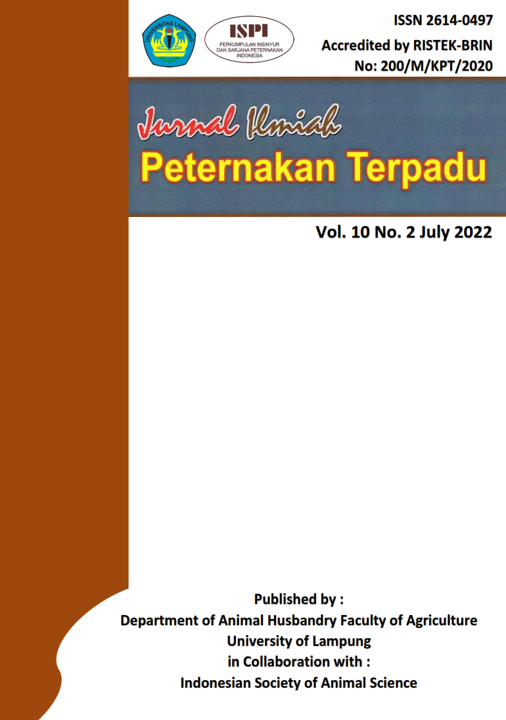Demand Pattern Analysis of Broilers by Satay Madura Sellers in Bandar Lampung City
DOI:
https://doi.org/10.23960/jipt.v10i2.p133-143 Abstract View: 391
Abstract View: 391
Keywords:
Broilers, Sellers, Demand, Pattern of demandAbstract
The purpose of this study is to determine the pattern of demand for broilers and the factors that influence the demand for broilers by Madura satay traders in Bandar Lampung City. This study uses a survey method. The sample is taken using a proportional random sampling technique with the number of respondents being 31 traders. Furthermore, the analytical method used is descriptive analysis and multiple linear regression with the Ordinary Least Square (OLS) Regression method. The result of the research shows that the pattern of demand for broilers by Madura satay traders in Bandar Lampung City consists of the frequency of purchase, the average number of purchases, and the place of purchase. The frequency of purchases made by Madura satay traders is seven times a week with an average number of purchases of 31 kg per week. Then, the usual place to make a purchase is the chicken trader in the market. The factors that significantly affect the demand for broilers are the price of chicken, the price of peanuts, the price of charcoal, and the price of output.Downloads
References
Adelina, H. A., D. Yusma, Elwamendri. 2017. Analisis permintaan kedelai pada agroindustri tempe di Kota Jambi. Jurnal Ilmiah Sosio Ekonomika Bisnis, 20(1): 1-11.
Arikunto, S. 2006. Metode Penelitian Kualitatif. Penerbit Bumi Aksara. Jakarta
Badan Pusat Statistik. 2018. Provinsi Indonesia dengan Konsumsi Daging Ayam Tertinggi Tahun 2017. Badan Pusat Statistik. Indonesia. https://www. bps.go.id/indicator/24/488/2/produksi-daging-ayam-ras-pedaging-menurut-provinsi.html. Diakses tanggal 30 Januari 2022.
Badan Pusat Statistik. 2019. Jumlah Penduduk Kota Bandar Lampung Tahun 2018-2019. Badan Pusat Statistik Provinsi Lampung. Lampung. https:// lampung.bps.go.id/indicator/12/45/1/jumlah-penduduk.html Diakses tanggal 30 Januari 2022
Debertin, D.L. 1986. Agricultural Production Economics. Macmillan Publishing Company. New York.
Gujarati, D.N. 2003. Basic Econometrics. Mc Graw Hill/Irwin. New York
Isaac, S., Michael. 1995. Handbook In research And Evaluation. EDITS. Michigan
Putriasih N.W., W.D. Sayekti, R. Adawiyah. 2015. Pola permintaan dan loyalitas pedagang soto terhadap bihun tapioka di Kecamatan Purbolinggo Kabupaten Lampung Timur. Jurnal Ilmu-Ilmu Agribisnis, 3(4) : 426-431.
Santoso H., F.D. Riana, L. Febri. 2013. Analisis permintaan dan strategi pengembangan agribisnis kopi di Indonesia. Malang: Agrise, 13(1) : 69-79.
Sari, M.A., M. Ktut, D.S. Wuryaningsih. 2017. Analisis permintaan ikan lele (Clarias sp) oleh pedagang pecel lele di Kota Bandar Lampung. Jurnal Ilmu-Ilmu Agribisnis. 5(2): 149-155
Sari, P.M. 2016.Analisis yang mempengaruhi konsumsi kedelai di Indonesia. Journal Economic and Economic Education, 4(1): 30-41.
Setiawan, N. 2006. Perkembangan konsumsi protein hewani di Indonesia: analisis hasil survey sosial ekonomi nasional 2002-2005 (The Trend of Animal Protein Consumption in Indonesia: Data Analysis of 2002-2005 National Socio Economic Survey). Jurnal Ilmu Ternak, 6(1) : 68–74. DOI: https://doi.org/10.24198/jit.v6i1.2270
Soekartawi. 2016. Agribisnis : Teori dan Aplikasinya. (Cetakan ke-11). Rajawali Pers. Jakarta
Sugiarto. 2003. Teknik Sampling. Gramedia Pustaka Utama. Jakarta
Downloads
Published
How to Cite
Issue
Section
License

Jurnal Ilmiah Peternakan Terpadu(JIPT) is licensed under a Creative Commons Attribution 4.0 International License.
Authors who publish with this journal agree to the following terms:
- Authors retain copyright and grant the journal right of first publication with the work simultaneously licensed under a Creative Commons Attribution License that allows others to share the work with an acknowledgement of the work's authorship and initial publication in this journal.
- Authors are able to enter into separate, additional contractual arrangements for the non-exclusive distribution of the journal's published version of the work (e.g., post it to an institutional repository or publish it in a book), with an acknowledgement of its initial publication in this journal.
- Authors are permitted and encouraged to post their work online (e.g., in institutional repositories or on their website) prior to and during the submission process, as it can lead to productive exchanges, as well as earlier and greater citation of published work (See The Effect of Open Access).





















